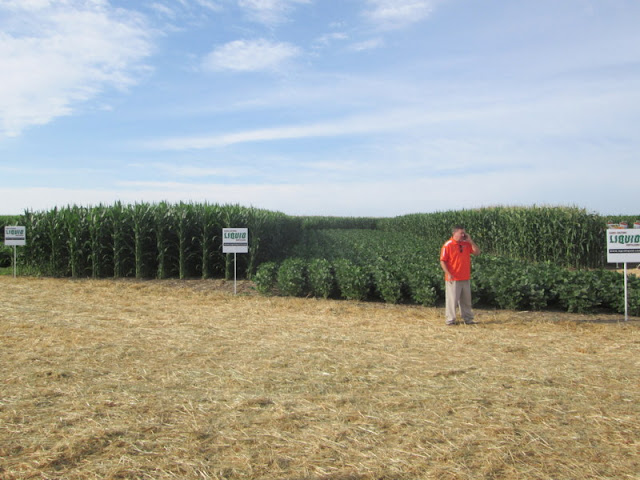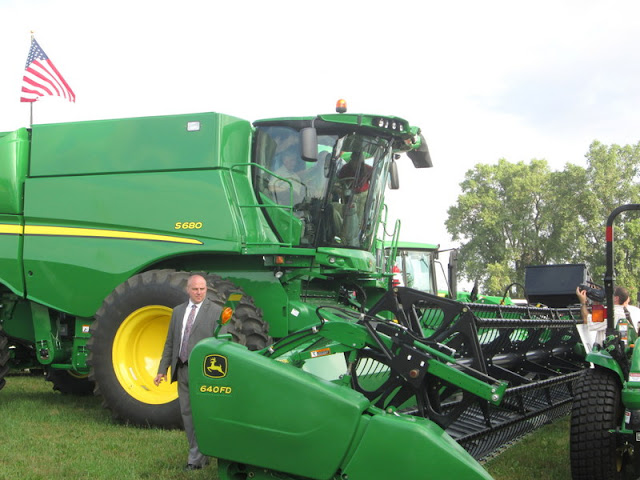So yesterday was the ever-popular Ag PhD Field Day in Baltic, SD. This is the fourth one that I have attended, and it is always a great day of education and socializing. (Has it really been a year since the last one?) Here is the AgroLiquid tent at the start of the row of exhibitor tents. There were a number of Liquid folks there including AM Chad, Agronomist Cory, SAM's Brad, Bruce and Aarron. And me. There was good traffic of people from all over the country through the tent. Everyone knew something about AgroLiquid from seeing us on the Ag PhD TV show, but now they got to find out more.
And look who else was representing: our CEO Troy! This was his first trip to the show, but certainly not his last. And who is welcoming him, none other than Darren Hefty, co-host of Ag PhD. I do like the color of the shirts. Great people, and teams, wear orange. OK, the formalities are over, time to get to work talking to folks about our favorite subject: Liquid Fertilizer!

So right at the start, Hefty Seed agronomist Van from the Buhl, ID store showed me these corn ears he had brought all the way from Idaho in a plastic bag with ice. He said the TSA agents at the airport were quite surprised, but let them pass. Anyway, they are from a high-yield field planted in 15" rows at a population of 60,000 plants per acre. (For you non-cornites, most corn is planted in rows that are 30" apart at a population around 30,000 seeds per acre, depending on conditions and yield potential. But this is one crowded field.) And for planter fertilizer, it got 12 gallons per acre of Pro-Germinator + 8 gallons per acre of Sure-K all in furrow. Now this too is higher than normal, but they are on a mission. (There were also micronutrients, but I don't remember what.) Anyway, at that population, it is surprising to see ears of this large size, so a big yield is anticipated. This is to show that Idaho can grow more than good potatoes.

Here we see Hefty agronomist Mike taking care of some final phone business before the show starts. Mike stayed in our tent all day as he is quite knowledgeable on Liquid. He is in front of the corn and soybean plots across from our tent. Actually, all of the corn and soybeans at the whole show got AgroLiquid fertilizer at planting. This would be all of the seed company plots, herbicide and fungicide plots. They all looked outstanding.
Here are some early birds making their way down the row of vendor tents on the right and accompanying plots on the left. Did I mention that all of the corn and beans got AgroLiquid at planting? Well they did.
Soon it was time for Brian and Darren to lead folks down the row of plots to explain what is going on. It was crowded. But very informative. They had something new this year: several Brian vs. Darren plots where they picked the different crop inputs like chemicals and the like. The fertilizer was Liquid, but they picked their rates.
There are several herbicide plots, including some new products, so it is very informative. And just in case you think it is staged in a low-weed pressure situation, just look up on the right side where there was no herbicide. It is solid weeds. I guess the no-chemical crowd can hoe or eat those weeds.
There was also a stop on cover crops. Always popular as they are rapidly gaining use. For non-farmers: cover crops are crops like specialty grasses and broadleaves, (like turnips or legumes), that can be planted after a crop is harvested like wheat or soybeans. This provides protection from erosion and can "scavenge" nutrients like nitrogen to keep it from leaching. It also can build soil organic matter. Then the crop is killed prior to planting the next year, which releases the nutrients back into the seed zone. There are a wide variety of cover crop programs.
Now the caravan is going past the AgroLiquid tent. Everyone listen as they explain what is gong on in the plots.
What is going on in this big bare spot? Well this is at the Dow Agrosciences tent. It seems that they have developed a new line of crop protection chemistry called Enlist Duo. This is a combination herbicide of 2,4-D and another herbicide. To go with that, they are working on the development of a new line of GMO corn that is resistant to the herbicide. This is of interest since you can't spray larger corn with 2,4-D without injury. Well the plan was to plant some of this corn for demonstration well past normal planting time, and then destroy it right after the show. But the EPA wouldn't let them since it isn't approved yet, and were worried about contamination or something. So it dragged on for awhile, then the official no. So this is where it was supposed to go. That darn government interference!

And who better to talk about government interference than the lunch guest speaker: Sarah Palin. This was quite a treat for the crowd, and crowded it was. She did not surprise or disappoint, as she talked about the similarities between farming and her commercial fishing for a living in Alaska. She did give acknowledgement to her farming relatives in North Dakota. She told how farmers built this country and feed the world, and would be better off if the government would back off the business of farmers. Now who can argue with that? I think we're all in debt to Sarah for stating what needed to be said. I am particularly glad that there were so many children there to hear that speech. Not only was it authentic, it expressed the courage little seen in this day and age.
Well the show went on through the afternoon as well. There were some estimated 5000 or more visitors. The weather, exhibits, guests, clinics, food and hospitality in 2013 will certainly make me return in 2014.
Thanks to Brian, Darren, and all of the Hefty Seed/Ag PhD folks for making this possible. (This was the end of my week. I will post about the start of the week next.) And thanks to Stephanie for her bringing everyone up to speed on what is happening at the NCRS this week as we prepare for the Research Field Days.


















































